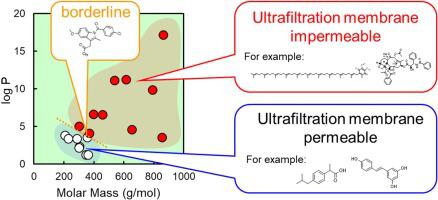Colloids and Surfaces B: Biointerfaces ( IF 5.4 ) Pub Date : 2021-09-03 , DOI: 10.1016/j.colsurfb.2021.112062 Asuka Inada 1 , Takumi Iwase 1 , Tatsuya Oshima 1

|
Casein hydrolysate (Pep) is a dispersant for poorly water-soluble drugs and nutraceutical ingredients. However, two types of complexes may be between Pep and poorly water-soluble molecules: those that are (1) dispersed as hydrocolloids in aqueous media with a particle size of 100–500 nm; and (2) not hydrocolloids, as indicated by permeability of the complex through an ultrafiltration (UF) membrane and the fact that the particle size is ambiguous by dynamic light scattering. This study was conducted to clarify the factors that determine the dissolution state of the complexes between poorly water-soluble ingredients and casein hydrolysate. We classified the dissolution state of the complexes between poorly water-soluble ingredients and Pep by the permeability using a UF membrane. Complexes containing larger and more-hydrophobic molecules are hydrocolloids and do not permeate the UF membrane, whereas complexes containing comparatively smaller and less-hydrophobic molecules do permeate the UF membrane. A complex containing indomethacin, which has borderline solubility properties, does not permeate the UF membrane at pH values in which the indomethacin carboxylic acid group is protonated, but it is permeable at pH values in which its carboxylic acid group is deprotonated. Furthermore, we determined the stoichiometry and association constant for the complex between a major peptide in Pep and poorly water-soluble resveratrol (Res) based on fluorescence quenching. We calculated the stoichiometry of Res and PepY to be 2:3 and the association constant to be 2.4 × 107 M−1.
中文翻译:

决定水溶性差成分与酪蛋白水解物复合物溶解状态的主要因素
酪蛋白水解物 (Pep) 是水溶性差的药物和营养成分的分散剂。然而,Pep 和水溶性差的分子之间可能存在两种类型的复合物:那些 (1) 以水胶体的形式分散在水介质中,粒径为 100-500 nm;(2) 不是水胶体,如复合物通过超滤 (UF) 膜的渗透性以及动态光散射导致颗粒大小不明确的事实所表明的。本研究旨在阐明决定水溶性差成分与酪蛋白水解物复合物溶解状态的因素。我们使用超滤膜通过渗透性对水溶性差的成分和 Pep 之间的复合物的溶解状态进行分类。含有较大和疏水性更强的分子的复合物是水胶体,不会渗透超滤膜,而含有相对较小和疏水性较低的分子的复合物会渗透超滤膜。含有吲哚美辛的复合物具有临界溶解度特性,在吲哚美辛羧酸基团被质子化的 pH 值下不会渗透超滤膜,但在其羧酸基团被去质子化的 pH 值下它是可渗透的。此外,我们基于荧光猝灭确定了 Pep 中主要肽与水溶性差的白藜芦醇 (Res) 之间复合物的化学计量和缔合常数。我们计算出 Res 和 PepY 的化学计量比为 2:3,结合常数为 2.4 × 10 而含有相对较小和疏水性较低分子的复合物确实会渗透超滤膜。含有吲哚美辛的复合物具有临界溶解度特性,在吲哚美辛羧酸基团被质子化的 pH 值下不会渗透超滤膜,但在其羧酸基团被去质子化的 pH 值下它是可渗透的。此外,我们基于荧光猝灭确定了 Pep 中主要肽与水溶性差的白藜芦醇 (Res) 之间复合物的化学计量和缔合常数。我们计算出 Res 和 PepY 的化学计量比为 2:3,结合常数为 2.4 × 10 而含有相对较小和疏水性较低分子的复合物确实会渗透超滤膜。含有吲哚美辛的复合物具有临界溶解度特性,在吲哚美辛羧酸基团被质子化的 pH 值下不会渗透超滤膜,但在其羧酸基团被去质子化的 pH 值下它是可渗透的。此外,我们基于荧光猝灭确定了 Pep 中主要肽与水溶性差的白藜芦醇 (Res) 之间复合物的化学计量和缔合常数。我们计算出 Res 和 PepY 的化学计量比为 2:3,结合常数为 2.4 × 10 在吲哚美辛羧酸基团被质子化的 pH 值下,它不会渗透超滤膜,但在其羧酸基团被去质子化的 pH 值下它是可渗透的。此外,我们基于荧光猝灭确定了 Pep 中主要肽与水溶性差的白藜芦醇 (Res) 之间复合物的化学计量和缔合常数。我们计算出 Res 和 PepY 的化学计量比为 2:3,结合常数为 2.4 × 10 在吲哚美辛羧酸基团被质子化的 pH 值下,它不会渗透超滤膜,但在其羧酸基团被去质子化的 pH 值下它是可渗透的。此外,我们基于荧光猝灭确定了 Pep 中主要肽与水溶性差的白藜芦醇 (Res) 之间复合物的化学计量和缔合常数。我们计算出 Res 和 PepY 的化学计量比为 2:3,结合常数为 2.4 × 10 我们基于荧光猝灭确定了 Pep 中的主要肽与水溶性差的白藜芦醇 (Res) 之间的复合物的化学计量和缔合常数。我们计算出 Res 和 PepY 的化学计量比为 2:3,结合常数为 2.4 × 10 我们基于荧光猝灭确定了 Pep 中的主要肽与水溶性差的白藜芦醇 (Res) 之间的复合物的化学计量和缔合常数。我们计算出 Res 和 PepY 的化学计量比为 2:3,结合常数为 2.4 × 107 M -1。











































 京公网安备 11010802027423号
京公网安备 11010802027423号